Hey content marketers! An SEO Content Brief is a great way to increase the chances of producing high-quality content. Unfortunately, many marketers just don’t know how to write a good one.
Have you ever wondered what great content briefs include?
How to create a content brief that will produce the articles that rank and bring organic traffic?
Not from time to time.
But each and every time!
We are sharing our experience and know-how on all the nitty-gritty details of the content brief.
With this guide, you’ll learn how to create content briefs that will help your writers produce better SEO-based articles. Plus with minimal revisions!
Want to write better SEO content faster? This guide is for you! So let’s jump in.
TL;DR
- A content brief is a detailed guideline for content writers that outlines the necessary requirements and suggestions for creating a piece of content, including the topic, keywords, target audience, and content objectives.
- An SEO content brief is a specialized type of content brief that is focused on creating content optimized for search engines.
- SEO content briefs provide benefits such as keeping the team aligned, delivering content on time and on target, improving search rankings, reducing production costs, and providing all critical information in one place, resulting in better quality content at scale.
- SEO content briefing is an invaluable tool that can be used to create SEO-friendly content to help businesses drive organic traffic and acquire customers.
- Content briefs provide a roadmap to create content that aligns with their project’s goals and allow content managers to have a clear and concrete strategy before their content writers begin creating content.
- A content brief should include a topic, keywords, target audience, content objectives, SEO writing instructions, tone/message/style, content structure/ outline, content examples, links/statistics, and visuals.
- According to SEMrush’s survey results, the most prioritized elements are a topic, keywords, target audience, and content objectives.
- To expedite, streamline, and enhance the accuracy of the process, you may opt to utilize content briefing tools such as SEOwind.
- A standard content marketing process includes: building a content marketing strategy, conducting research, creating a content calendar, creating content briefs, writing, editing, publishing, promotion, and further optimization.
- Content Briefs serve as a link between planning and operational phases and provide writers with everything they need to write content that ranks.
- Content briefs are mostly used for creating new content. However, they are also a great tool to use for content optimization, making it easier to expand and optimize existing content.
- Using an SEO content brief template can make the whole process easier and more unified.
- Being involved in the creation process and involving stakeholders in planning and creation can improve the quality of content.
Everything you need to know about SEO Content Briefs – infographic
To get started, we have created an informative infographic that covers the basics of what content briefs are, why they are important, and who should use them. Additionally, we included a sample SEO content brief template for you to reference.
Later in the article, we will delve deeper into each of these topics, providing you with a thorough understanding of how to use content briefs effectively in your content marketing strategy.
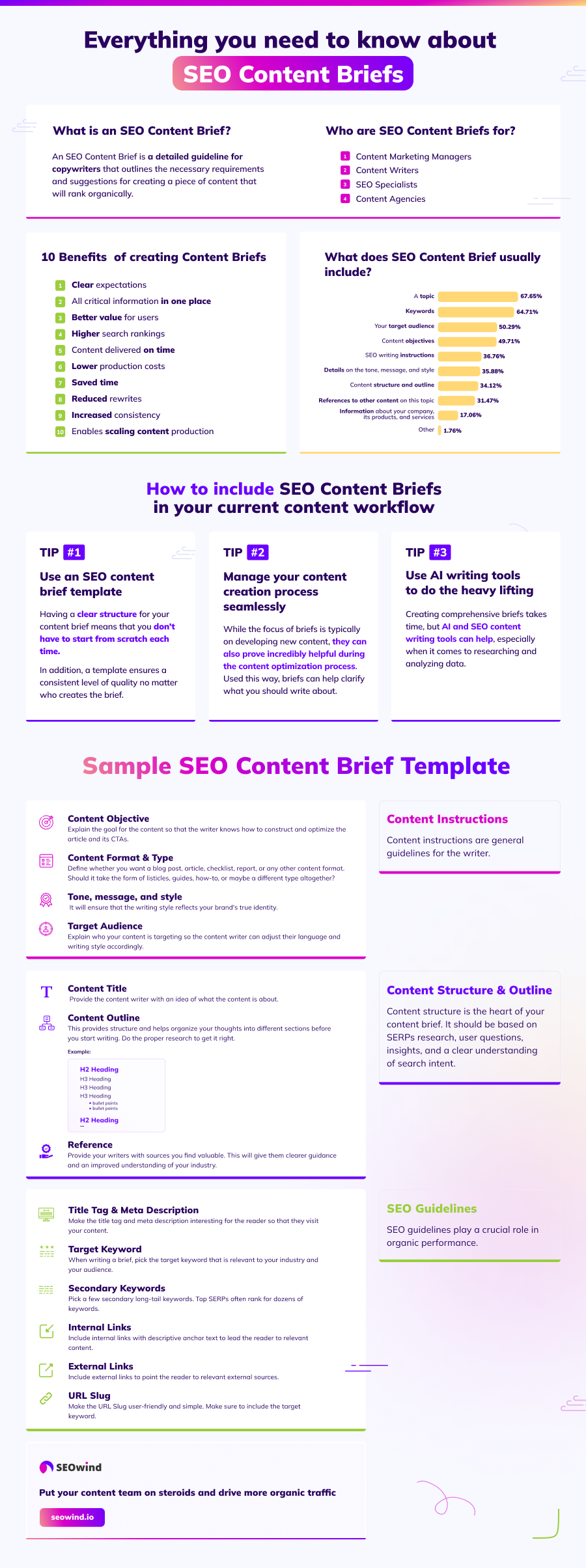
What is a Content Brief? Content Brief Definition
A content brief is a detailed guideline for content writers that outlines the necessary requirements and suggestions for creating a piece of content. Research shows, that it commonly includes essential details such as the topic, primary keywords and secondary keywords, target audience, and content objectives. Additionally, it may offer comprehensive information regarding SEO instructions, tone of voice, content structure and outline as well as references to other relevant content elsewhere.
Writers, editors, and content strategists use briefs in the content creation process to provide a clear understanding of the expectations, context, and desired outcome. It helps to guide your content creation in an organized, efficient manner.
No matter whether you’re working alone, in internal or external teams, small or big teams. It brings value to whatever your case is.
(Did you know that the word brief dates back to the 1200s? It ultimately derives from the Latin brevis, which means “short.”).
What’s the risk of not using content briefs?
Without a content brief, you run into the risk of receiving content that doesn’t meet your needs. You are letting your writer operate in the dark… or to put it in different words, you are letting them create the content that they think might be useful. A lot of guessing here which usually doesn’t contribute well to quality and the desired outcome.
But before going into details, let’s talk about where SEO is in all of this.
How does SEO-Content Brief differ from Content Brief?
SEO content briefs can do wonders for SEO, but what is an SEO content brief you might ask?
Well, an SEO content brief is a specialized type of content brief focusing on creating content optimized for search engines. It’s designed to produce content that can rank well for specific searches and earn traffic from the organic search channel.
Compared to content briefs it will put more emphasis on SEO research and guidelines. If you are creating content to deliver value to your audience and you want it to perform well in organic searches then this is the topic you should dig deeper into.
Benefits of SEO Content Briefs
Have you ever asked yourself, what the SEO content brief role is? If not, then it’s time to start paying attention. Here’s why:
1. A content brief puts your entire team on the same page.
When everyone is clear on the goal of the article, it’s easier to achieve it.
By setting out the specific objectives and content details for each article you can make sure that everybody understands it in the same way and that the expectations are clear. This makes all the stakeholders stay aligned and the content creator will not stray from your goals and requirements.
Using SEO content briefing can help less experienced writers create content at a higher level, which is beneficial for both the writer and the reader.
2. The content brief supports delivering content on time
Having a brief for your content can assist writers in getting drafts back more quickly. They understand what you expect from them which means they don’t need to guess.
This means delivering faster and more on target.
In a nutshell: better SEO content at scale.
3. Improve Your Content’s Search Rankings
Writers’ primary skill is… guess what… writing. They usually know a bit about SEO, and they learn your industry fast but still, they are not an expert in any of those.
If you’re scaling content by working with a large number of authors, you can’t expect them to know or understand complex SEO nuances. With a content brief, you are increasing your chances to develop content that meets both your target audience and Google’s needs.
4. Reduce Content Production Costs
A content brief can help reduce content production costs. If the writer gets a specific and well-defined outline then this reduces the time and money spent on fixing a weak draft. What’s more, the first draft usually is the one that is accepted.
It is extremely helpful if you outsource content creation to an external content writer.
5. All the critical information in one place
An SEO content brief is a detailed document that provides all the information needed for a writer to create the content you want. It includes specific details on what the article should cover, as well as keywords and other relevant information that can help boost rankings.
This will ensure that you’ll get a piece that covers all the key points.
Your copywriter (and editor) will work 2x faster.
There’s no room for rewrites or changes when you have tight content or creative brief. Critical information is communicated upfront, and everyone is on the same page.
You can even use it as a checklist to make sure your search engine optimization (SEO) is on point.
Win-win.
Who is SEO Content Briefs for?
SEO content briefing is an invaluable tool that can be used to create SEO-friendly content to help businesses drive organic traffic and acquire customers.
Content briefs are used by internal marketing teams (for their internal and external copywriters) as well as content marketing agencies who are cooperating with various customers.
It can be a helpful tool for people taking different roles in the content creation process:
- Content Marketing Manager
Content briefs are invaluable tools for content managers, providing them with a roadmap to create content that aligns with their project’s goals. Creating a detailed content brief before beginning a content project can be time-consuming, but the time investment pays off. Content briefs allow content managers to have a clear and concrete strategy before their content writers begin creating content; plus, content briefs can guide content creation quickly so the team can achieve their desired objectives in a timely manner. Content briefs also provide the solid ground from which teams can make sure their content is staying on track and meeting expectations. Thus, content managers often take the time to create comprehensive and detailed content briefs to ensure that all of their projects run smoothly and efficiently.
- Content Writers
Content briefs provide a great foundation for content writers (freelance writers as well as internal content writers), allowing them to quickly understand what is expected from them. It lets them get familiar with the topic and the objectives of the content. Besides helping writers understand what’s expected of them, these detailed outlines of actionable points also help improve the overall quality of a piece. With SEO content briefs, content writers have all the guidelines necessary to produce effective SEO-friendly content without worrying about having to guess what criteria should be met. Quality SEO-optimized content not only increases organic search engine rankings but can also help increase website click-through rates, helping businesses maximize their overall online visibility and appeal.
- SEO Specialists
SEO content briefs can be a powerful tool in the SEO specialist’s arsenal. By taking the time to properly craft an SEO content brief, SEO specialists can provide content writers with detailed instructions on topics and keywords they need to use. This gives writers more confidence and guidance in the content creation process, allowing the SEO specialist to put out high-quality work with maximum impact. Furthermore, SEO content briefs save time and can help establish a much-needed dialogue between SEO specialists and content writers, enabling them to coordinate important details and ensure everything they are maximizing the potential gains.
SEO Content Briefs Statistics and its elements
What elements should you include in Content Briefs? Content briefs are essential components of SEO and copywriting activities, but what do those documents typically include?
According to SEMrush’s survey results, marketers prioritize the most basic elements: a topic (67.45%), keywords (64.71%), target audience (50.29%), and content objectives (49.71%). And almost 37% also have instructions for optimizing their writing for search engines!
Marketers also claim to include the following elements:
- Details on the tone, message, and style (35.88%),
- Content structure and outline (34.12%),
- References to other content on this topic (31.47%),
- Information about your company, its products, and services (17.06%).
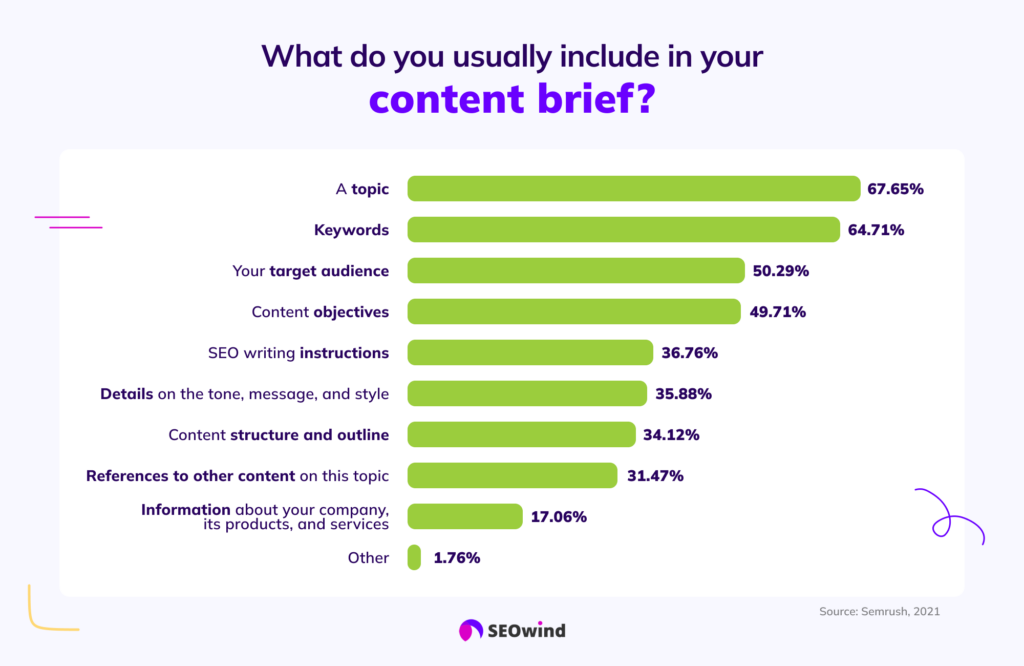
What does a brief usually look like – in-depth analysis
Now that we know what elements are typically included in content briefs.
Let’s go into detail about what they are. We will go one by one through the content brief elements mentioned in the Semrush research.
1. Topic
The content brief should include a topic and title. It doesn’t have to be exact. It needs to show the direction of what you want the content to be.
2. Keywords
Primary Keyword
The main goal of SEO content is to rank on search engines and drive organic traffic. When writing a brief pick the target keyword that is relevant to your industry and your intended audience.
Mind the keyword difficulty. If you are just starting your content marketing adventure, then better pick up keywords with low to medium.
Secondary Keywords
In addition to a primary keyword, you should also pick a few secondary long-tail keywords.
These keywords are closely tied to your primary keyword. They help you rank for a variety of search terms.
Don’t obsess over secondary keywords. The BERT update means that Google can understand the nuances of any search query, even if there isn’t a perfect match. This will still deliver relevant search results and help you find what your customers are looking for!
Bottom line: pick one primary keyword and a few variants.
3. Target audience
Every piece of content that you create has a target audience and it’s important for the writer to know who they are writing for.
Why? You will be writing in a completely different style when you have a primary target audience of C-level executives versus teenagers.
Target audience is a key component in creating quality content because it can make or break how well people receive your article.
4. Content Objectives (Intended Results)
The content brief should explain your goal for the content in question so that the writer knows how to construct and optimize the article and its CTAs. Do you want to educate people, convenience them to consider your product, or maybe guide them?
5. SEO writing instructions
Most content writers are not SEO experts. Their primary skills are writing, doing research, and making a creative story. It’s your job to cover SEO aspects in your content brief to give them the right tools so that they are able to deliver the content that ranks.
6. Details on the tone, message, and style
You shouldn’t overlook the importance of brand voice and writing style when creating brand-related content like articles or blog posts. Including brand voice and writing style in your brand’s content briefs ensures that the narrative surrounding your brand reflects its true identity. Is your brand voice witty, professional, casual, or maybe straightforward? It will all impact the flow, usage of words, and the way the writer conveys the key message.
7. Content structure and outline
This is the heart of the content brief. Something that if done right makes a huge difference in the content creation process. The same rules apply to blog post outlines as well as an outline for website content.
What is the outline’s role in the content brief? Let’s go back to school.

Whenever you were writing an essay you were expected to divide your content into certain logical sections. The same rule applies here.
A content outline is a crucial part of any blog post or article. It gives structure and helps organize thoughts into different sections before you start writing. Usually, they take the form of headings and subheadings.
It provides the writer with the context and they can make sure they include all the necessary information.
A content outline can be turned into a table of contents once the article is ready. It makes it more clear to readers what they can expect from your content, which can help you rank higher in search engines like Google.
8. Content examples and references
It’s ok to share some links to content that you find valuable for the writer to follow. It might give them a better direction and understanding of your industry.
Your best chance to outrank your competitors at scale on Google and gain tons of organic traffic is to play the game according to Google’s rules.
Remember that Google’s goal is to provide the user with the best answer possible. To do that, the search engine uses machine learning to understand the user’s intention and provide them with content that best answers the query.
That means that the answer to the question is already there, and if you’re not a scientist working on cutting-edge technology, you probably won’t come up with a breakthrough that will change the world and SERP results.
9. Links and Statistics
Links and statistics covering the topic is a great way of making it stand out. This way you can deliver value to the reader. It will also increase your reliability.
Including links and statistics in a content brief is an effective way of ensuring the content stands out. It also creates a more engaging experience. This way readers have access to trustworthy facts and statistics that originally come from reliable sources.
10. Visuals
Write down how many images and visuals you are expecting to be used.
Visuals are images that give a representation of words or ideas. They can be in the form of graphs, images, drawings, etc. Visuals allow for easier understanding by readers – especially when they present abstract concepts – because they provide an image instead of just numbers which may not make sense without context for what they represent.
Pro-tip on visuals:
- There is no magic number for how many images should be included. You can use the rule of thumb and say to use an image every 500 words.
- A good practice is to look at the top 5 SERPs on the topic/keyword you are writing and verify how many images they use.
You can also include a list of stock image websites that you like so that it is easier for the content writer to choose the more relevant ones. Most companies use the following websites to get stock images:
How do you write a content brief in only a few minutes
Looking for a quick way to write SEO-focused content briefs?
Go ahead and listen to Tom, SEOwind CGO, on what the process of creating content brief looks like and how you can optimize it.
How to write a Killer Content Brief with SEOwind- step by step
So we know what should be inside the brief, now the question appears: What do you write a content brief? Where should you start?
To learn more on how to create effective content briefs with SEOwind with a detailed step-by-step guide and explanation of each step visit: How to create a content brief with SEOwind? Best practices in SEOwind
No worries, we have you covered. We will walk you through step by step process of writing an SEO content brief that will help you rank!
Step 1: Start with the Focus keyword
Some people might say that keywords are passé and they are not working. Sure Google doesn’t want you to stuff your content with keywords. Believe me, the keywords are still working and they are fine.
You don’t want to write content that nobody is looking for. Starting with the keyword will guide you the right way.
Step 2: Review the top SERPs
Top SERPs are the goldmine of what to write about on the chosen topic. You can:
- analyze the search intent behind the keyword,
- understand what types of pages rank,
- decide how long your content should be,
- identify what other keywords and topics you should cover,
- select what headings and subheadings to include.
Step 3: Choose your Secondary Keywords
👉 Usually top SERPs are ranking for many more than just one keyword. This gives you valuable insights into what kind of topics you can also cover when creating content on a given topic. In SEOwind, we’re showing you organic keywords top SERPs are ranking for in the top 30, with search volume above 10. What’s even better we’re clustering keywords with AI so that it is easier for you to use them across the content you’re creating.
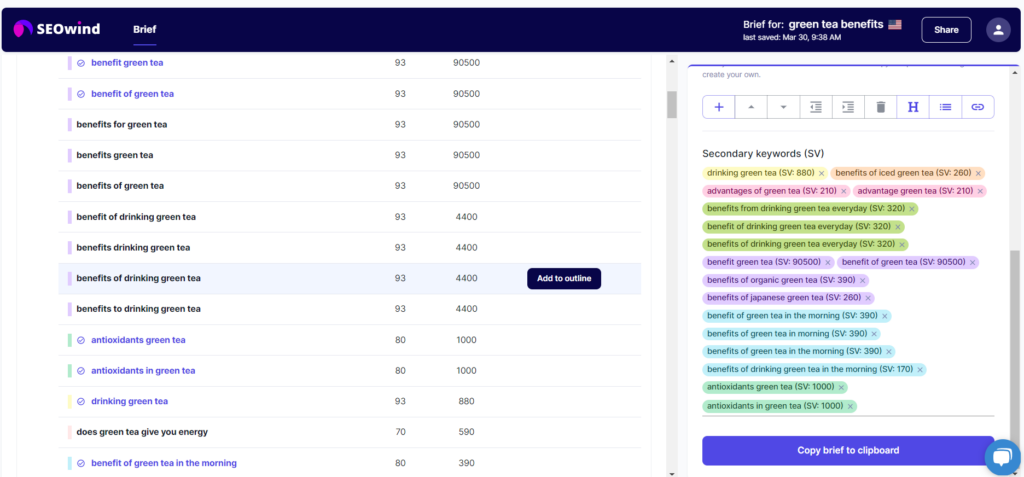
Step 4: Create a Content Outline – add headings and subheadings
How do you create a content outline?
You can either leverage AI to create an automated outline or do it manually.
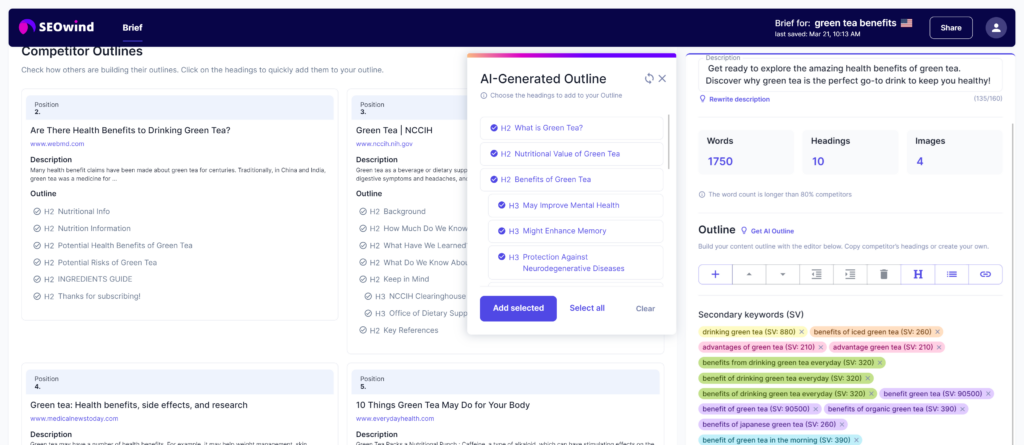
Here’s a six-step checklist for manual outline generation:
- Enter your primary keyword on google. Look at the SERPs.
- Identify the search intent behind the query.
- Closely analyze the top ten pages.
- Find common headers, subtopics, and questions your competitors’ content answers. This will give you an idea of how to structure your outline.
- Add any external links you would like your content writer to get familiar with. The best way would be to provide them with the relevant ones to the particular topic that you want to cover in a particular section.
- Use the People Also Ask tool to find questions related to the keyword.
💡 Looking for more tips on how to create a proper content outline? Get familiar with our article on Content Outline for Article – Practical How-To Guide for SEO Success
Pro-tip regarding outline and main key takeaways:
- Look for ways to stand out from the competition. Make yourself familiar with the skyscraper technique. It comes in handy here.
- Use headings and subheadings.
- Keep them short and concise so that people don’t get bored with reading through too much text on one page.
- Make headings meaningful.
- Use keywords or make it clear for the writer to use them.
👉 Our tool, SEOwind, gathers all the top SERPs and their outlines in one place. So that it is easier for you to decide on which topics, and subheadings to include. If you copy any headings from pages already ranking you will automatically have the source in your outline.
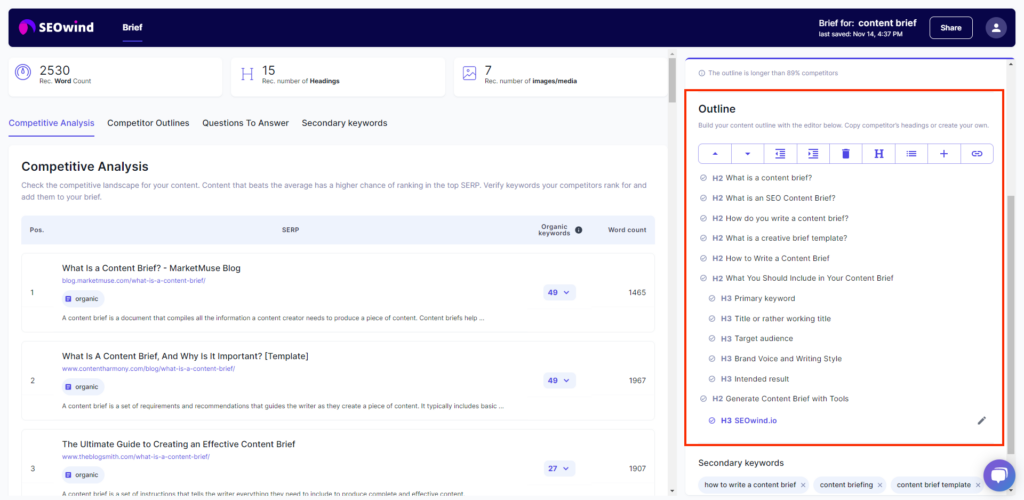
Step 5: Add additional value on top
Usually, people have various questions regarding the topic.
Let’s take the content brief as an example and look at sample questions around it:
- How do you write a content brief?
- What should be included in a content brief?
- What is content brief SEO?
- What makes a good content brief?
- What is an example of a content brief?
- How to write a content brief?
- What does a brief look like?
- What’s the hardest thing about writing a content brief for an article optimized for SEO?
Yada yada yada… There are quite a lot of them. Some are very specific, some are general.
You can find those questions through Google People Also Ask, Google Suggest, Quora, or Reddit.
👉 Our tool, SEOwind, makes your job easier. We are analyzing PAA along with Quora questions to gather the data you might need for creating your SEO-optimized keyword content brief.

Step 6: Decide how long your content should be
Content length is an important factor to consider when creating a content brief. Make sure that your topic can be effectively covered in the word count you have allotted. Going over or under your word count can negatively affect the quality of your content. Word count can be also helpful to avoid bringing a 500-word post to a 2,500-word fight.
While there isn’t necessarily a “correct” word count for an article, it’s generally recommended to aim for around 1,500 words. This will give you enough space to cover your topic thoroughly, while still keeping the article length manageable.
Pro-tip for suggested word count:
- Check what is the industry standard length of the keyword or topic you want to rank for.
👉 Our tool, SEOwind, calculates recommended word count based on the average word count of top-ranking articles on Google. This means taking guessing out and basing the recommendation on data. Let’s have a look at recommendations regarding the word count for the article “Content Brief”
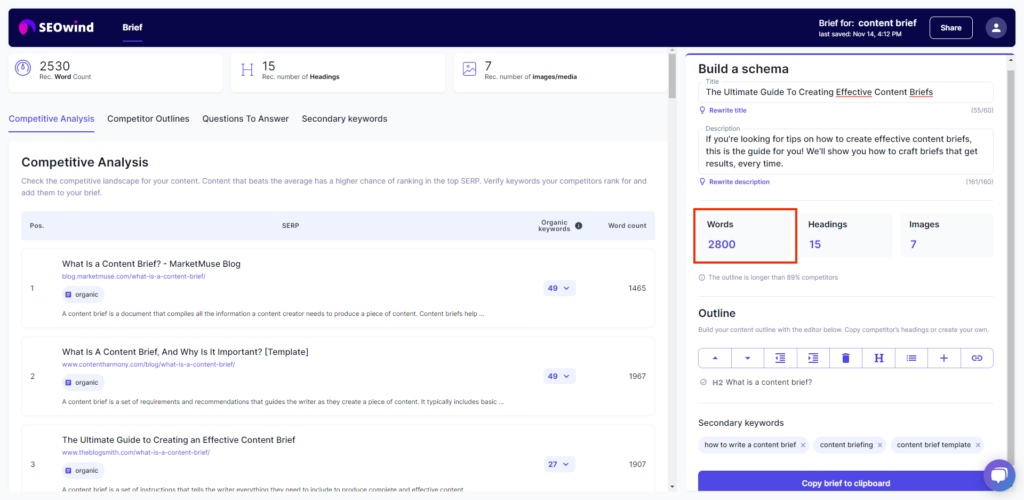
Word count is an accurate way to estimate article cost, which can be helpful if you’re paying by the word. Do your research before sending out briefs so that it doesn’t come back with a high price tag on!

Content Briefs in your Content Marketing Process
Marketing content workflows can vary between companies. A standard content process can look like this:
- Building content marketing strategy,
- Conducting topic and keywords research,
- Prioritizing topics and putting them into clusters,
- Creating a content calendar and content plan,
- Creating content briefs,
- Writing,
- Editing and content optimization,
- Publishing,
- Promotion,
- Further content optimization.
Where do content briefs fit in the content production process?
Content brief as a marketing tool can be important in 2 places in your content workflow.
- The content briefing is an essential link between having a content calendar and the writing process, so between the planning and operational phase. From our perspective, each piece of content that you have in your content plan should have a brief associated with it. This way the content you write will reflect the goals you have.
- What’s more, the content briefs will impact also further stages of the content creation process. They provide content writers with everything they need to write articles, blog posts, websites, or any other piece of content that ranks. Comprehensive content briefs make research and editing can be minimized. Rewrites and edits happen seldom. Ultimately, this means more efficient production of content that drives traffic and lets you reach the goals you want.
Most people use content briefs only when creating new content.

So so wrong!
Content briefs are also a great tool to use for content optimization. Let’s say you identified the content you would like to expand and optimize. But then the question comes up: what shall I write about? Preparing a content brief for that can be a great way of structuring your thoughts and approach. Doing proper research on what ranks, what kind of content they cover, and what kind of questions people have can serve as a great source of information for developing the content that already ranks.
Include SEO content briefs in your current content production process
Likely your content team is already having their content production process in place. Each change in a process is triggering some resistance and it takes some time to fully embrace it. Let’s go through a couple of tips that can make incorporating comprehensive content briefs much easier.
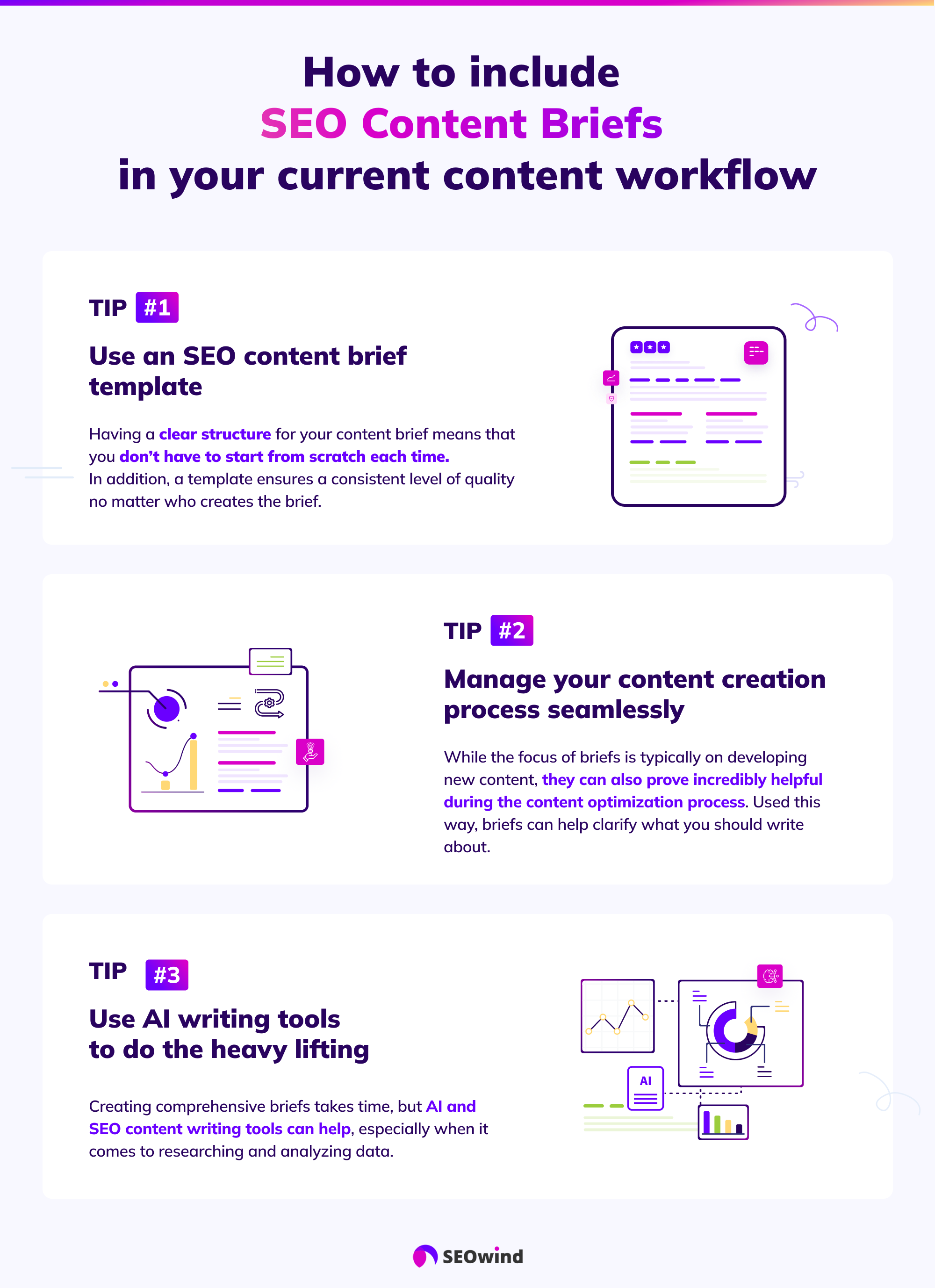
Tip 1: Use an SEO content brief template
Having a clear structure for your content brief and not starting each time from scratch can make the whole process easier and more unified. No matter who will be in charge of creating a brief you can be sure that it will be of the same, good quality.
You can divide the content brief template into:
- Consistent company-related information – information on the tone of voice, your products, and services, competitors,
- Unique information – related to the particular brief and keyword you are aiming at.
Once you start working with briefs, your content writers will get used to the framework.

Anders Thornild, Digital Marketing Manager from CyberPilot, says that the most important step to implementing SEO content briefs was a great template and to implement this template in the content creation process. The template should be easy to fill out and have all the important pieces of information.
It’s important to revisit the template several times. Get some feedback from the people who fill it out and the writers who take the information and make it into the content, because it won’t be perfect in the first shot and it must fit your current processes.
💡 If you want to find out what is a content brief template and go through content brief examples visit: Content Brief Templates & Examples to Create Great Content
Tip 2: Manage your content creation process seamlessly
Understand where the content briefs fit.
They can be helpful when writing new content. But not only. You can also use them when your team is dealing with content optimization processes. This way you will know how to expand your content and what to write about.
Tip 3: Be Involved in the Creation Process

Luciano Colos, Founder and CEO of PitchGrade, rightly points out, that too often, SEO content briefs are overlooked in the content creation process. The most effective way to ensure that you’re getting the best content possible is to make sure that the person writing your content knows what needs to be included for SEO purposes.
By including an SEO brief with your content creation process, you can ensure that you’re getting the best information possible. The best way to ensure that your SEO content brief is being followed is to be involved in the creation process. Don’t leave it to the writer to come up with the information; instead, make sure that your own SEO content brief is being followed.
Not only will this ensure that the information is being included, but it will also ensure that you’re getting the quality content that you expect. By being involved in the content creation process, you can make sure that your SEO content brief is being followed and that you get the best content possible.
Tip 4: Use AI writing tools to do the heavy lifting
Creating comprehensive briefs takes time. This is where AI and SEO content writing tools come in handy. Especially when it comes to researching and analyzing data. Lucky for you, there are content brief generators like SEOwind to support you. Have all the data at your disposal regarding top SERPs, keywords they rank for, keyword clustering, and questions people ask. Make cautious decisions about what and how to write about.
Tip 5: Involve Stakeholders in Planning and Creation

Incorporating comprehensive SEO content briefs into your company’s content creation process can be a game-changer for your brand’s online visibility and search engine ranking, says Chinmay Daflapurkar, Digital Marketing Associate of Arista Systems. Here’s a tip to make the process easier: involve all relevant stakeholders in the planning and creation process!
This includes the content creators, marketing, and SEO teams, and any subject matter experts. By having everyone on the same page, confusion and miscommunication can be avoided, and it will align the content with the overall SEO strategy.
To make the process even more seamless, establish a clear and consistent format for the content briefs. This includes sections for goals, target audience (buyer persona), keywords, tone, and any other relevant information. With this structure in place, everyone will know exactly what is expected, and it streamlines the entire process. Finally, don’t forget to regularly review and update the content briefs. This ensures that they remain relevant and aligned with the company’s SEO goals.
5 tips and tricks for creating SEO-based content briefs
Now, if you’re like most people, you probably don’t have a lot of time to spend on creating briefs, but you still want results. Luckily for you, these tips are going to make the process a lot easier. So, let’s get started
How to write a better SEO Content Brief – SEO Guidelines & Instructions

SEO (Search Engine Optimization) guidelines are important because they help companies rank their websites on the first page of Google.
By using them you ensure that the content is optimized for search engines. As a result, it will be easier to rank well on Google and bring the traffic you want.
SEO professionals should keep SEO guidelines in mind when creating blog posts or articles.
Primary keyword
Include the primary keyword in the content brief.
Why it is worth using keywords when creating content
SEO would not be possible without keywords because they are what people search for most often when looking for something online. If you use the phrases your audience searches you are increasing your likelihood of being found by your audience. That’s why it is essential to do proper keyword research.
Check also keyword intent – it will help you get your content right.
In a nutshell, use the primary keyword that has search volume and is relevant to your audience.
How can I identify the keywords I should use
It is also important to use SEO tools to find target keywords and check how competitive those keywords are. To find relevant primary and secondary keywords, SEO professionals can use keyword research tools such as SEMrush or Ahrefs.
Where should the keywords be included?
Include keywords throughout the article. Use the primary keyword and its variations several times throughout the article. It will help to improve SEO rankings and ensure that the landing page or a blog post is found by potential customers.
Pro-tip on keywords:
- Don’t favor keywords with high volume over high intent match
- Don’t try to jam keywords into articles. Put value over keywords.
- Include keywords in the title and meta description of an article.
- Placing the primary keyword at the beginning of the title, as well as in the first sentence of the article, will help to improve SEO rankings.
Secondary keywords
While the primary keyword is the most important, it is also important to include secondary keywords in the content brief. Secondary keywords can help to improve SEO rankings, help to ensure that the website is found by the right people, and provide them with the information they are looking for.
Topic suggested
Topics cannot be overlooked in brief.
Google raised the bar and is trying to understand more complex searches and how they connect to each other. Thanks to topics, Google can understand the website from a much broader perspective and provide solutions that aren’t an exact match to the keyword put into the search.
Instead, topics and topics alone can provide the answer; the user gets what they want.
So if you have any terms, or phrases that are relevant to this topic, even the broader ones, they are worth mentioning in the content brief. Using them will mean that the content is more relevant.
Title and Meta description
The first time someone sees a website is on the search engine results page (SERP). The meta title of a webpage is what will show up on the search engine results page (SERP) as well as on social media, such as Facebook and Twitter.
Meta title
SEO guidelines state that the meta title should be between 50 and 60 characters long, including spaces. SEO professionals can use SEO tools to check if a meta title is too long or too short as well as the competitiveness of the keywords used in the title.
The primary keyword, as well as other relevant keywords, should be included as well as a call to action (CTA).
Meta description
The meta description is what will show up on search engine results pages (SERPs) and social media. The meta description should be between 150 and 160 characters long, including spaces. SEO professionals can use SEO tools to check the length of a meta description as well as the competitiveness of the keywords used in the meta description.
Including keywords in the meta description is important for SEO, but it is also important to write a meta description that is compelling and encourages potential customers to click on the website. The meta description should also include a call to action. Including a CTA in the meta description will help ensure that companies reach their target market and convenience them to take certain actions.
💡 For more information on meta description go to How To Write A Meta Description That Drives Clicks [Tips & Examples]
Internal links
Internal links are links on a webpage that allows the company to link to other relevant articles or pages of its own website.
Using internal links is beneficial for SEO as it can increase user experience by making it easy for people to navigate the website and find relevant pages on their website. Besides, internal links influence SEO rankings by making it easy for search engines to crawl the website.
When an internal link sits within an article, it’s called deep-linking because it’s linking further down into information than where the external link is found. This makes for a higher SEO ranking and more reader engagement with your content.
Pro-tip regarding internal links:
- Include Internal Links With Descriptive Anchor Text
External links
External links are links that are on your website that point to other sites. You can also think of them as “links out” on your site that link to other places on the internet.
Some people are afraid of using external links within their website as they fear that they are directing the traffic out of their website.
I prefer to think about it differently.
It just shows your competence, know-how in depth, and willingness to deliver value for your user. I’m not saying that you should direct the user to your competitor page (sure you can do it if you want) but show relevant pages, that broaden the topic.
Frequently Asked Questions on Creating SEO Content Briefs
1. Are content briefs different from creative briefs?
Yes, content briefs and creative briefs are different. Both of them are documents presenting requirements. Creative briefs are used for various marketing projects and campaigns, whereas content briefs are typically used for creating long-form content, often written but not limited to.
Creative briefs are typically used for marketing campaigns, marketing research, creative design projects, web design projects, and other design projects. Whereas content briefs are used for creating written content, such as blog posts, articles, reports, or listicles.
2. When should I use a content brief?
Whenever the content is being created! Every time!
If you are writing yourself, a content brief is great for structuring your ideas, thoughts, research, and approach. If you are cooperating with the writer, it is even more important as the content brief conveys the crucial information to include in the article or any other piece of content.
In a nutshell, a content brief is the best way to deliver content that achieves its goals.
3. What do you think of the Content Brief Generators?
Content brief generators can be incredibly useful tools for writers and content creators.
One of the key benefits of using a content brief generator is that it saves time. Rather than spending hours researching and compiling information on a particular topic, a content brief generator can quickly provide an overview of the key points that need to be covered. This allows writers to focus on crafting high-quality content without getting bogged down in research.
Moreover, content brief generators can help streamline the writing process by providing a clear outline of the content piece, making it easier for writers to structure their work and ensure they cover all the necessary points.
Still, always verify what kind of data they use for creating the content briefs. The best outline generators create content based on SEO data, not only AI.
💡 Want to find out more about content outline generators? Visit: The Best SEO and AI Outline Generators, For You
4. Who writes a content brief?
A content brief is typically written by a content strategist, marketing manager, or project manager who is responsible for overseeing the development of content for a particular project. Additionally, it’s not uncommon to see SEO specialists or consultants involved in creating content briefs as well, especially when the main goal is to optimize the content for search engines.
Happy content briefing!



